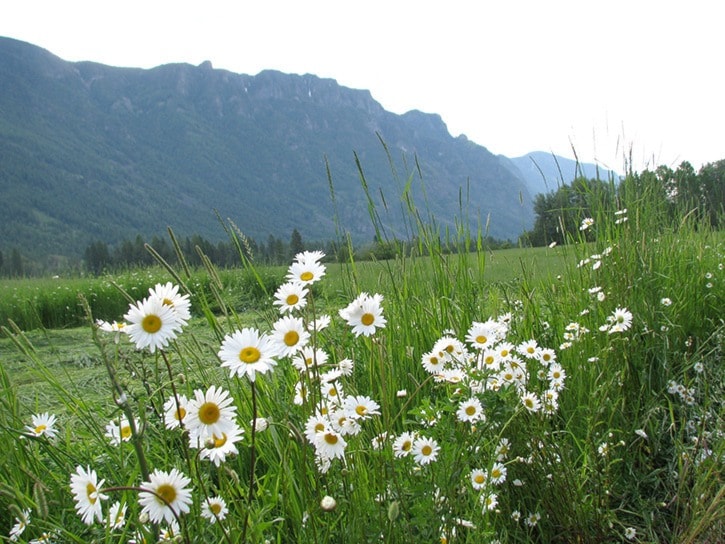A debate about reducing the required lot sizes in Lister from 20 to 10 acres isn’t going to go away quietly, if sentiments expressed at Monday night’s Creston Valley Food Action Coalition meeting are any indication.
Following remarks by Lister farmers Randy Meyer and Wayne Harris, not a word was spoken in support for the Regional District of Central Kootenay Area B’s advisory planning commission’s proposed changes to the official community plan (OCP). Meyer, a member of the APC, was one of nearly 40 in attendance.
Last week, another APC member, Pat Martin, went public with her own concerns about the proposal’s potential impact on farming.
Harris, whose family runs Kootenay Meadows Farm (formerly Kootenay Alpine Cheese), an organic operation whose products include cheese and milk, told the meeting that the Agricultural Land Reserve (ALR), created in 1973, made B.C. “probably the first place in the world to preserve agricultural land in legislation.”
Only two to four per cent of the province consists of arable land, he said, the most productive of which is in the Fraser, Okanagan and Creston valleys. Large tracts in the Cariboo and Peace River regions are generally suitable only as ranchlands.
“The ALR froze parcel sizes, with some exceptions, including home sites,” Harris said.
Home sites usually included two acres and were exempted primarily to allow for retiring farmers to remain on their land.
The Creston Valley is unique in B.C. because lot sizes vary according to the area. Erickson, Canyon, Lister and the Creston flats each have their own requirements.
Harris said history is largely responsible. First World War soldiers from Great Britain were lured to Lister with 20-acre parcels of land. Many were unsuccessful as they tried to grow crops unsuited to the land, which is largely clay-based, has restricted water availability and whose microclimate is often considerably cooler — by as much as 10 degrees Celsius — than Creston and Erickson.
In the years following the Second World War, Harris said many of the holdings had been sold, often to German immigrants, to farmers who better understood the land’s potential.
“Lister is best suited for feed crops and grain production,” he said. “Not many horticultural crops will succeed there.”
Harris and Meyer both spoke from personal experience about the challenges that smaller parcel sizes bring. Kootenay Meadows Farm consists of 100 acres, but the operation requires another 500 acres of leased land to grow sufficient feed for its animals. Those 500 acres are comprised of more than two dozen parcels.
Smaller parcels mean more residences, and invite more conflict between farmers and non-farming residents, who might object to the smells and noises that are part of agricultural life. The 20-acre parcel size in Lister has been a contributing factor in some dairy operations relocating to the Creston flats, where larger parcel sizes and fewer neighbours mean fewer conflicts. Selling off a farm that consists of several individual parcels is a profitable temptation.
Meyer, who produces beef, chickens and hay, supplements his 40-acre farm with another 200 acres of leased land. He said farming on smaller plots gets less practical as their size is reduced. Even a 20-acre lot, with a house, outbuildings and driveways, is a challenge to maneuver farming equipment around, and the impracticality of farming smaller parcels reduces their appeal, he said.
As an APC member, “the main issue that has me, along with others, fired up is this move to reduce the lot sizes in Lister,” he said. “If this is allowed, you can bet there are going to be a lot more subdivision applications.”
While the Agricultural Land Commission (ALC) has the final say in subdividing plots within the land reserve, it can be influenced by an area’s OCP, which is intended to reflect the wants and needs of local residents.
Nadine Ben-Rabha, a food action coalition director who also works with her family on Kootenay Meadows Farm, said that while there is no indication that the ALC wants to approve subdivisions in Lister, a change to the OCP could influence future direction.
Meyer said that he believed that most Lister residents don’t support a reduction in parcel size.
“But there are people who would like to sell part of their land and stay on what is left to live,” he said. “I can see their side of it. …
“But new owners who have no roots here and who don’t really care about what we have here aren’t very good for our community, either.”
For a decision this important, a general discussion is premature, Meyer said.
“There should be an economic impact study so everyone will understand the losses versus gains, community-wise,” he said.
Several speakers in the audience encouraged those in attendance to attend pertinent meetings and to talk to their friends and neighbours about the issue. Petitions for both Area B residents and other Creston Valley residents are now being circulated in an effort to generate interest.
“We really have a rare resource here in Creston,” Ben-Rabha said. “At the cheese factory I see people coming from all over the Kootenays because they care about what we have here. Why would we want to pave it? Once the land gets cut up, we can’t go back.”
